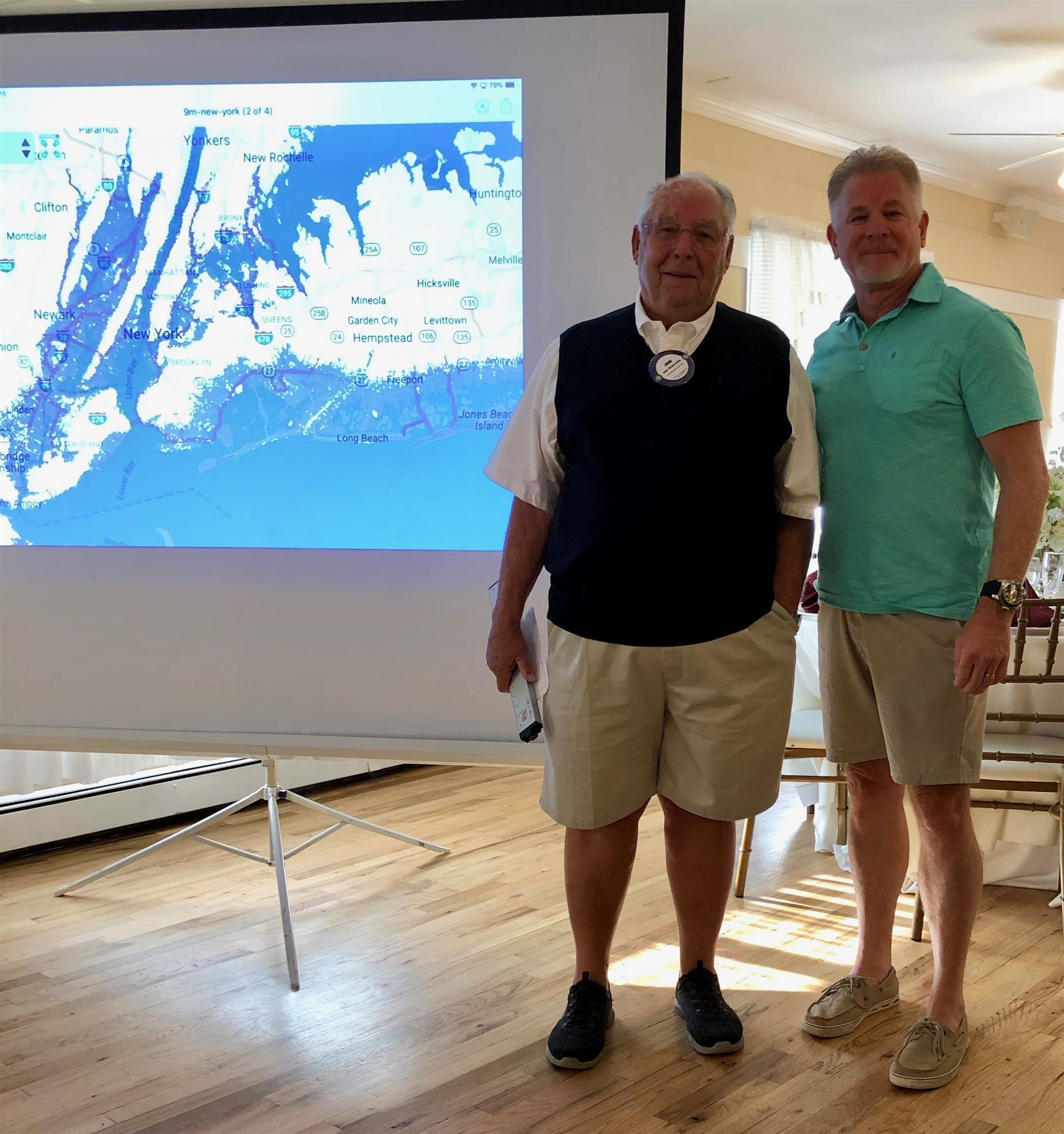 OUR JOHN WINTERSTELLA DISCUSSED THE LONG TERM EFFECT OF GLOBAL WARMING ON RISING SEAS. A FOUR FOOT INCREASE IS PROJECTED BY 2021 THAT COULD CAUSE SEVERE FLOODING IN NYC AND NEW JERSEY WHERE THE BELT PARKWAY AND PARTS OF THE GARDEN STATE PARKWAY AND NEWARK AIRPORT WILL BE UNDERWATER DURING HIGH TIDE. ENGINEERS HAVE PROPOSED PUTTING FLOODGATES AT INLETS BUT JOHN A DAM BETWEEN SANDY HOOK AND LONG ISLAND.
OUR JOHN WINTERSTELLA DISCUSSED THE LONG TERM EFFECT OF GLOBAL WARMING ON RISING SEAS. A FOUR FOOT INCREASE IS PROJECTED BY 2021 THAT COULD CAUSE SEVERE FLOODING IN NYC AND NEW JERSEY WHERE THE BELT PARKWAY AND PARTS OF THE GARDEN STATE PARKWAY AND NEWARK AIRPORT WILL BE UNDERWATER DURING HIGH TIDE. ENGINEERS HAVE PROPOSED PUTTING FLOODGATES AT INLETS BUT JOHN A DAM BETWEEN SANDY HOOK AND LONG ISLAND.The week’s speaker was the club’s own John Winterstella, former mayor of Manasquan. John talked mostly about projected flooding in the Metropolitan area by 2120 and an idea he has in order to combat it.
Due to global warming, a four-foot rise is projected to happen in sea level height. “The low tide will be four feet higher, and the high tide will be four feet higher,” John said. The rise in sea level will have a huge effect. Engineers have mentioned putting floodgates at inlets. John doesn’t believe the idea will work.
John showed a few different pictures throughout his presentation. Flooding was seen in multiple areas. John stated there will be quite a bit of flooding in the Hoboken-Jersey City area. The Passaic River area is projected to be “pretty much” flooded. Severe flooding is predicted to occur in Manhattan. It’s also predicted that the Belt Parkway will be underneath water. Most ports, including Newark Liberty International Airport, will be underneath water at high tide. New York City’s mayor, Bill de Blasio, has made a proposal to “shore up” lower Manhattan (the project would cost $10 billion). Ravi S. Bhalla, mayor of Hoboken, recently revealed that he expects the state and federal governments to provide several billion dollars to “shore up” the coastline in his area.
Floodgates at inlets is one idea. Walls around towns is another idea. However, John has his own idea: dams. John suggests building a dam which would go from Sandy Hook over to Long Island. The dam would have a road and bridges along its top so people can make trips. It would have to be a gigantic dam. The dam would have small boat locks, where fishing boats and recreational boats could be moved out. There would also be two major locks for larger ships. Ships would be able to get into ports. It’s certainly possible to accomplish all the engineering. The dam would protect the Raritan Bay area as well.
The Metropolitan area is a crucial area to save since it has the stock market, many banks, as well as other institutions that need protection. A little barrier around Manhattan Island won’t work.
A question some may have is “What happens when the water comes through Hell Gate (top of the East River)?” John proposes to construct another dam which would extend from Long Island to Connecticut. Again, a road would be put on top of the dam. Plus, these dams can have tidal turbines; a great deal of electricity could be provided. Traffic situations may develop, but remember the bridges to Manhattan will be flooded.
As far as more local, the Garden State Parkway to the Cheesequake area is near two feet above flood level. The Parkway near Keyport is practically the same level. Protective measures have to be done in these areas. When Manasquan Inlet has been the subject, at least some have said to “dig the river deeper.” John doesn’t see the idea as a solution; he’s not sure the flooding will be reduced. Floodgates won’t solve the problem either.
Now, as for the money, John proposes to use the financial and administrative powers held by the New York and New Jersey Port Authority. The Port Authority not only has fund-raising and administrative capabilities, but it also has engineering capability. The Port Authority would be able to take on the project.
John believes it’s important to have conversations with others about the projected flooding. Tell the information in this article to people you know. The right courses will need to be taken. “Every politician I talk to about this says, ‘Well, I’m not going to be around when this goes on.’ Well, they’re not,” said John. “But the problem is their grandchildren may be. We have to do something in the foreseeable future because we can’t build the project overnight.”